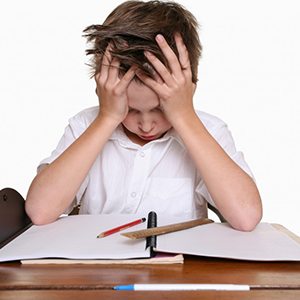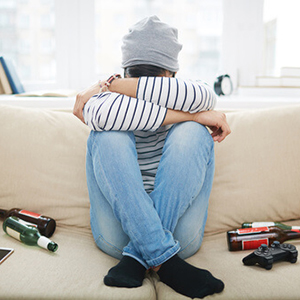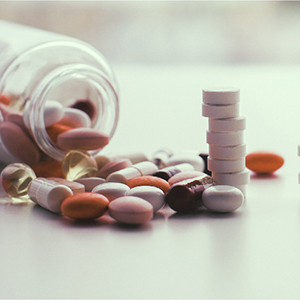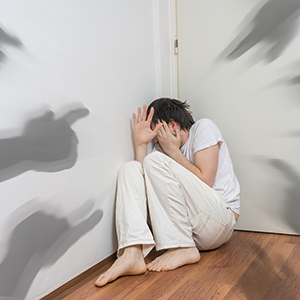
A.D.D AND A.D.H.D
What is ADHD: A General Overview?
Attention Deficit Hyperactivity Disorder (ADHD) is a disorder characterized by a persistent pattern of inattention and/or hyperactivity/impulsivity that occurs in academic, occupational, or social settings. Problems with attention include making careless mistakes, failing to complete tasks, problems staying organized and keeping track of things, becoming easily distracted, etc. Problems with hyperactivity can include excessive fidgetiness and squirminess, running or climbing when it is not appropriate, excessive talking, and being constantly on the go. Impulsivity can show up as impatience, difficulty awaiting one's turn, blurting out answers, and frequent interrupting. Although many individuals with ADHD display both inattentive and hyperactive/impulsive symptoms, some individuals show symptoms from one group but not the other.

ANXIETY DISORDERS
Everyone periodically experiences fear and anxiety. Fear is an emotional, physical, and behavioural response to an immediately recognizable external threat (eg, an intruder, a car spinning on ice). Anxiety is a distressing, unpleasant emotional state of nervousness and uneasiness; its causes are less clear. Anxiety is less tied to the exact timing of a threat; it can be anticipatory before a threat, persist after a threat has passed, or occur without an identifiable threat. Anxiety is often accompanied by physical changes and behaviours similar to those caused by fear.
Some degree of anxiety is adaptive; it can help people prepare, practice, and rehearse so that their functioning is improved and can help them be appropriately cautious in potentially dangerous situations. However, beyond a certain level, anxiety causes dysfunction and undue distress. At this point, it is maladaptive and considered a disorder.
Anxiety occurs in a wide range of physical and mental disorders, but it is the predominant symptom of several. Anxiety disorders are more common than any other class of psychiatric disorder. However, they often are not recognized and consequently not treated. Left untreated, chronic maladaptive anxiety can contribute to or interfere with treatment of some general medical disorders.
Mental distress that occurs immediately or shortly after experiencing or witnessing an overwhelming traumatic event is no longer classified as an anxiety disorder. Such disorders are now classified as trauma- and stressor-related disorders

ALCOHOL AND DRUG ADDICTIONS – BRIEF OVERVIEW
For all the positives that mind and body altering substances have brought us, one fact is clear, there have always been people who were unable to restrict their use of mind and body altering substances to culturally prescribed limits, and who have fallen into the trap we know today as addiction.
Addiction usually does not happen overnight. Rather, people who become addicted to drugs (such as alcohol, cocaine, heroin, marijuana, etc.) are gradually introduced and desensitized to them over a period of time. They may initially enjoy the use of drugs in a recreational sort of way. For instance, someone might get into the habit of having a beer or some wine after work as a way of releasing the days' stresses. Someone else may use marijuana on an occasional basis as a way to share special time with friends or as an aid to appreciating food, music, or sex. Another person may start using cocaine as a way of staying up late at night to study for exams.
Some people are able to keep using drugs on an occasional basis. Many other people are not so lucky. For these unlucky others, their use of drugs begins (gradually in some cases, abruptly in others) to increase, and the amount of attention they spend thinking about getting high, purchasing drugs, preparing drugs and taking drugs increases until it becomes the center of their lives. Other responsibilities - work, friends and family, and community - fall by the wayside. As their consumption of drugs rises, users may become physically dependent on their drug to the extent that if they do not take it on a particular day, they get sick. As dependence increases, tolerance to the drugs increases as well - meaning that it takes more and more of the drug to get the same 'high' or 'buzz' effect. As most drugs (with the exception of alcohol) are illegal, they may become increasingly involved in criminal activities (buying drugs is a criminal activity, as is driving while intoxicated). If the process continues long enough, it may become impossible for the addict to hold a job - they may lose their relationships, their income and their marriages. They may resort to criminal activity (such as robbery, prostitution and drug dealing) in order to gain continuing access to their drugs. They may also kill or injure other people (through driving and firearm accidents) while intoxicated, and may get and pass along to others infectious diseases (like AIDS and Hepatitis). Ultimately, they may end up killing themselves (through suicide, malnutrition, overdose, or drug related physical degeneration and disease). A grim picture that is all the more tragic because no one who starts out experimenting with a drug ever really believes that they would ever experience any of these awful things.

BIPOLAR DISORDER – WHAT IS BIPOLAR DISORDER
Bipolar disorder, formerly called manic depression, is a mental health condition that causes extreme mood swings that include emotional highs (mania or hypomania) and lows (depression).
When you become depressed, you may feel sad or hopeless and lose interest or pleasure in most activities. When your mood shifts to mania or hypomania (less extreme than mania), you may feel euphoric, full of energy or unusually irritable. These mood swings can affect sleep, energy, activity, judgment, behaviour and the ability to think clearly.
Episodes of mood swings may occur rarely or multiple times a year. While most people will experience some emotional symptoms between episodes, some may not experience any.
Although bipolar disorder is a lifelong condition, you can manage your mood swings and other symptoms by following a treatment plan. In most cases, bipolar disorder is treated with medications and psychological counselling (psychotherapy).

DEPRESSION
An individual with major depression, or major depressive disorder, feels a profound and constant sense of hopelessness and despair. Major depression is marked by a combination of symptoms that interfere with the person's ability to work, study, sleep, eat, and enjoy once pleasurable activities. Major depression may occur only once but more commonly occurs several times in a lifetime.
Sometimes physical problems can cause depression. But other times, symptoms of depression are part of a more complex psychiatric problem. There are several different types or subtypes of depression, including:
- Major depressive disorder
- Dysthymia and chronic depression (now called persistent depressive disorder)
- Seasonal affective disorder
- Psychotic depression
- Bipolar depression
- Major Depression

MEDICATION MANAGEMENT
Used appropriately, medications can alleviate distressing symptoms that compromise physical and psychological well-being, help prevent the onset of many acute and chronic illnesses, and improve patient health outcomes. Too often, however, medications are not used appropriately. In addition to problems involving adverse drug events, many patients do not receive optimal pharmaceutical prescriptions. Even when optimal therapy is prescribed, patient inability to adhere closely to medication regimens may lead to poor health outcomes.
Medication-related problems are especially pronounced among older adults.
Medication therapy management (MTM) services are intended to address issues of polypharmacy, preventable adverse drug events, medication adherence, and medication misuse. MTM is the current term that represents a suite of health care services that have evolved out of the philosophy and processes described in the early 1990s as “pharmaceutical care.

OBSESSIVE COMPULSIVE DISORDERS - What is OCD?
Obsessive Compulsive Disorder (OCD) is a mental health disorder that affects people of all ages and walks of life, and occurs when a person gets caught in a cycle of obsessions and compulsions. Obsessions are unwanted, intrusive thoughts, images or urges that trigger intensely distressing feelings. Compulsions are behaviours an individual engages in to attempt to get rid of the obsessions and/or decrease his or her distress.
Most people have obsessive thoughts and/or compulsive behaviours at some point in their lives, but that does not mean that we all have “some OCD.” In order for a diagnosis of obsessive compulsive disorder to be made, this cycle of obsessions and compulsions becomes so extreme that it consumes a lot of time and gets in the way of important activities that the person values.
Here is one way to think about what having OCD is like:
Imagine that your mind got stuck on a certain thought or image… Then this thought or image got replayed in your mind over and over again no matter what you did…
You don’t want these thoughts — it feels like an avalanche… Along with the thoughts come intense feelings of anxiety… Anxiety is your brain’s alarm system. When you feel anxious, it feels like you are in danger. Anxiety is an emotion that tells you to respond, react, protect yourself, DO SOMETHING!
On the one hand, you might recognize that the fear doesn’t make sense, doesn’t seem reasonable, yet it still feels very real, intense, and true… Why would your brain lie? Why would you have these feelings if they weren’t true? Feelings don’t lie… Do they? Unfortunately, if you have OCD, they do lie. If you have OCD, the warning system in your brain is not working correctly. Your brain is telling you that you are in danger when you are not. When scientists compare pictures of the brains of groups of people with OCD, they can see that some areas of the brain are different than the brains of people who don’t have OCD. Those tortured with OCD are desperately trying to get away from paralyzing, unending anxiety…

PSYCHOTIC DISORDER – WHAT IS IT?
The disorder is characterized by symptoms which may include delusions, hallucinations, disorganized speech or behaviour, or catatonic behaviour. These symptoms may be caused by different psychotic conditions such as; schizophrenia, schizoaffective disorder, delusional disorder and psychosis in severe bipolar disorder. They may also be caused by a drugs (such as amphetamines) or medical conditions (such as a brain tumours).
Psychotic disorders are amongst some of the most dangerous disorders which need to be diagnosed and treated early. Prolonged duration of untreated psychotic disorders may lead to incidences of suicides and homicides, amongst others; making these disorders psychiatric emergencies.

TRAUMA AND STRESS RELATED DISORDERS
Trauma-and stress-related disorders result from exposure to a traumatic or stressful event. Specific disorders include acute stress disorder and posttraumatic stress disorder. These disorders cause similar symptoms but differ in how long they last. Acute stress disorder typically begins immediately after the event and lasts from 3 days to 1 month. Posttraumatic stress disorder lasts for more than 1 month. It may develop as a continuation of acute stress disorder or develop separately up to 6 months after the event.
These disorders are no longer considered anxiety disorders because many affected people do not have anxiety. They have other symptoms instead. For example, they may be unable to experience pleasure, become aggressive, or feel restless and discontent, angry, numb, or disconnected from themselves.
